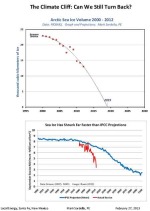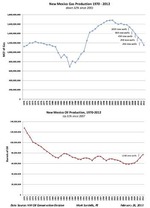Waldorf Commencement Address
 Jun 9, 2013 at 10:27AM
Jun 9, 2013 at 10:27AM I was honored to give the commencement address to the Santa Fe Waldorf School's 2013 graduating class. The full text of my speech is here.
 Jun 9, 2013 at 10:27AM
Jun 9, 2013 at 10:27AM I was honored to give the commencement address to the Santa Fe Waldorf School's 2013 graduating class. The full text of my speech is here.
 Mar 10, 2013 at 11:42PM
Mar 10, 2013 at 11:42PM A formatted copy of this post is available here. (PDF - 483kB)
I recently provided expert witness testimony to the New Mexico Senate Conservation Committee for a bill to ban the spread of a controversial method of oil and gas extraction known as high-volume hydraulic fracturing, or "fracking."
New Mexico is still highly reliant on revenues from its oil and gas operations, so the bill would have allowed hydraulic fracturing to continue in the two main shale basins where it is already occurring, while banning it throughout the rest of the state.
The bill was resoundingly defeated in committee, gaining only the support of the committee chairman, Senator Peter Wirth, and the sponsor, Senator William Soules.
In my testimony, I cited five reasons to ban the spread of fracking in New Mexico:
Reason #1: Encroachment into Pristine Lands New Mexico’s oil and gas operations are primarily taking place in the Permian and San Juan Basins, located in the southeast and northwest corners of the state, respectively. But new regions of New Mexico, including our most pristine watersheds and agricultural lands, are beginning to open up to oil and gas production as a result of horizontal drilling and hydraulic fracturing technologies.
New Mexico’s oil and gas operations are primarily taking place in the Permian and San Juan Basins, located in the southeast and northwest corners of the state, respectively. But new regions of New Mexico, including our most pristine watersheds and agricultural lands, are beginning to open up to oil and gas production as a result of horizontal drilling and hydraulic fracturing technologies.
The encroachment of oil and gas operations into the center of the state poses significant risk to New Mexico's limited water supplies. Some of the chemicals being used for hydraulic fracturing are so toxic that even small releases in watersheds, reservoirs or rivers would inflict significant damage. The worst offenders are endocrine disruptors, for which there is no safe dosage. A few molecules present in a glass of water can be harmful, meaning that once water has been contaminated with an endocrine disrupting chemical, it cannot be reclaimed through purification.
Reason #2: Oilfield Spills On the Rise Spills in New Mexico’s oil and gas fields set records in 2012, with nearly 700 self-reported accidents over the course of the year, according to the online database of spills posted by the New Mexico Oil Conservation Division. Causes ranged from the mundane, such as trucks running over pipes and workers falling asleep while tanks overflowed, to the extreme, including well blowouts, casing ruptures and pipeline bursts. The 2.7 million gallons of hazardous materials reportedly spilled in 2012 is a small fraction of what was actually released, because many spills are entered into the database with a zero typed in the “amount spilled” column. Furthermore, many spill events may be going unreported. One compliance inspector I spoke with remarked, “If we hear about 10 percent of them, we’re good.”
Spills in New Mexico’s oil and gas fields set records in 2012, with nearly 700 self-reported accidents over the course of the year, according to the online database of spills posted by the New Mexico Oil Conservation Division. Causes ranged from the mundane, such as trucks running over pipes and workers falling asleep while tanks overflowed, to the extreme, including well blowouts, casing ruptures and pipeline bursts. The 2.7 million gallons of hazardous materials reportedly spilled in 2012 is a small fraction of what was actually released, because many spills are entered into the database with a zero typed in the “amount spilled” column. Furthermore, many spill events may be going unreported. One compliance inspector I spoke with remarked, “If we hear about 10 percent of them, we’re good.”
At least 17 spills during 2011 involved fracking fluids, which contain the most dangerous of the chemicals in use. By the time one leak was repaired in Eddy County, New Mexico, more than 8000 gallons of hydrochloric acid, water and fracking chemicals had spilled from a tank and seeped down into the ground.
At least thirty reported spills during 2011 and 2012 impacted a waterway or groundwater supply. In one example, an equipment failure at a well pad in San Juan County allowed 15,000 gallons of crude oil and water to spill, sending a toxic flow into Lewis Park Canyon a few miles upstream from Navajo Lake State Park.
Groundwater can also be contaminated due to a failure of well casing integrity, which often goes unnoticed. Despite claims that multiple layers of steel and cement prevent hydrocarbons from migrating into fresh-water aquifers, several studies show that about six-percent of all new wells have poor casing integrity. And a study published in Oilfield Review shows that half of all oil and gas wells in the Gulf of Mexico lack casing integrity after 15 years.
Reason #3: A Growing Consumption of Fresh Water Data reported by industry to FracFocus show that usage of fresh water in New Mexico hydraulic fracturing operations more than doubled last year, rising from 221 million gallons in 2011 to 518 million gallons in 2012. The number of wells fracked grew 39 percent over that time, but the primary culprit is increased water usage per well, which rose from 485,000 per well in 2011 to more than 830,000 gallons the following year. If the trend continues, fracking in New Mexico will consume more than one-billion gallons of fresh water in 2013. Unlike water used in agriculture, the water consumed by fracking can never be reclaimed as drinking water, because it is first permanently contaminated by endocrine disrupting chemicals, and then it is pumped into deep injection wells, removing it from the hydrologic cycle.
Data reported by industry to FracFocus show that usage of fresh water in New Mexico hydraulic fracturing operations more than doubled last year, rising from 221 million gallons in 2011 to 518 million gallons in 2012. The number of wells fracked grew 39 percent over that time, but the primary culprit is increased water usage per well, which rose from 485,000 per well in 2011 to more than 830,000 gallons the following year. If the trend continues, fracking in New Mexico will consume more than one-billion gallons of fresh water in 2013. Unlike water used in agriculture, the water consumed by fracking can never be reclaimed as drinking water, because it is first permanently contaminated by endocrine disrupting chemicals, and then it is pumped into deep injection wells, removing it from the hydrologic cycle.
Reason #4: A Frightening Contribution to Climate Change
When  methane (natural gas) is burned it emits carbon dioxide, contributing to climate change, but if the methane is released directly to the atmosphere without first being burned, the impact on climate is many times worse. Hydraulic fracturing has been shown to significantly increase direct releases of methane. When fracking fluids are withdrawn from the well after a frack job, the “flowback” contains a significant amount of methane, which is often vented rather than flared. Further, occurrences of methane bubbling up in freshwater streams after nearby fracking operations suggests that fracturing can open direct pathways from underground hydrocarbon reservoirs to the atmosphere. These releases could be a game-ender for our efforts to stabilize the climate.
methane (natural gas) is burned it emits carbon dioxide, contributing to climate change, but if the methane is released directly to the atmosphere without first being burned, the impact on climate is many times worse. Hydraulic fracturing has been shown to significantly increase direct releases of methane. When fracking fluids are withdrawn from the well after a frack job, the “flowback” contains a significant amount of methane, which is often vented rather than flared. Further, occurrences of methane bubbling up in freshwater streams after nearby fracking operations suggests that fracturing can open direct pathways from underground hydrocarbon reservoirs to the atmosphere. These releases could be a game-ender for our efforts to stabilize the climate.
A straightforward calculation of reflected solar energy shows that the disappearance of summer ice in the Arctic will create a climate forcing roughly on par with the one humans created by burning fossil fuels. Estimating how long it will be before the summer Arctic ice is gone is also fairly straightforward, involving a simple forward projection of the ice-loss trend of the past ten years. My projection of the data suggests that the Arctic will be ice-free in the summer in 2019. On our current course, by 2020 the natural climate forcings will have surpassed the anthropogenic ones, and humankind will be powerless to stop the relentless onset of climate instability.
Reason #5: Risk of Continued Reliance on Oil and Gas New Mexico’s economy continues to be strongly dependent on oil and gas revenues. It is prudent, therefore, to undertake a realistic assessment of how stable these industries are, and to determine how long the resources might last. And, there is cause for concern.
New Mexico’s economy continues to be strongly dependent on oil and gas revenues. It is prudent, therefore, to undertake a realistic assessment of how stable these industries are, and to determine how long the resources might last. And, there is cause for concern.
Gas production in New Mexico is down more than thirty percent since 2001, and the decline is certainly not for lack of drilling. More than a thousand new gas wells were brought online in 2007, and yet the amount of gas produced the following year fell by four percent. Another 856 new gas wells came online in 2008, and production fell once again – this time by more than five percent. Every year, even as hundreds of new gas wells were brought online, production continued to decline.
The decline of New Mexico gas production is not unexpected. With continued extraction, any finite resource will eventually go into decline. When drilling hundreds or even thousands of new wells each year fails to stem a decline in production, the resource is nearing its end days. It doesn't mean that the resource is running out – there is still plenty of gas underground. Rather, the effort required to find and produce the resource is rising to levels that cannot be sustained.
The rate of oil extraction in New Mexico, by contrast, is undergoing its most significant increase in fifty years. But it’s not because new “gusher wells” are being found, or vast, new reservoirs are being tapped. As a finite resource, oil is bound by the same laws of decline. The “easy” oil is long gone. Continuing to produce oil means drilling deeper, then drilling horizontally, and then injecting toxic chemicals at high volume and high pressure, requiring diesel-powered pumps rated tens-of-thousands of horsepower, just to coax a little oil out of the ground. Even with all that effort, fracked wells are exceptionally short-lived and must be re-fracked in a few years. The decline of oil can already be seen in the rising consequences of extracting it, and a decline in the extraction rate will soon follow.
I concluded my testimony with the following statement:
"In 1923, an engineer from Standard Oil convinced the U.S. Surgeon General that it was safe to blend a known neurotoxin with gasoline. Subsequent studies showed that 68 million American children were exposed to toxic lead levels and 325,000 Americans died from exposure to leaded gasoline.
In 1970, electric utilities convinced the U.S. Environmental Protection Agency that coal-fired power plants posed no threat to public health. Subsequent studies showed that particulate pollution from coal-fired power plants was killing 30,000 Americans annually. The current best estimate is still around 13,000 deaths per year.
In 2005, the oil and gas industry convinced Congress that slickwater, multi-stage hydraulic fracturing in horizontal wells is so safe that it should be exempt from enforcement under the Safe Drinking Water Act. What is unfolding in the wake of that deception is arguably the most serious public health threat ever perpetrated by the energy industry."
I'll post the responses to my testimony shortly. A video of the hearing is available here.